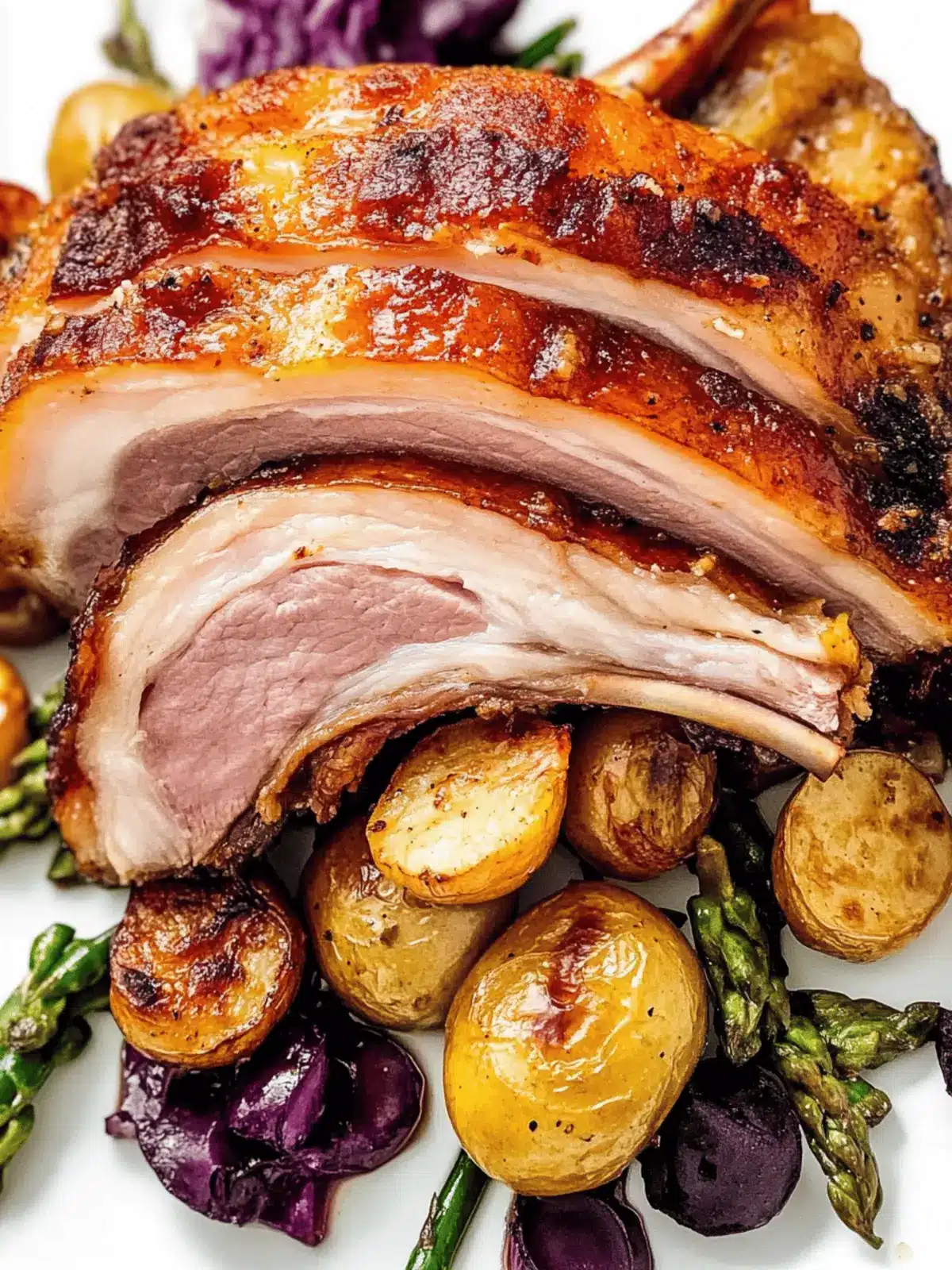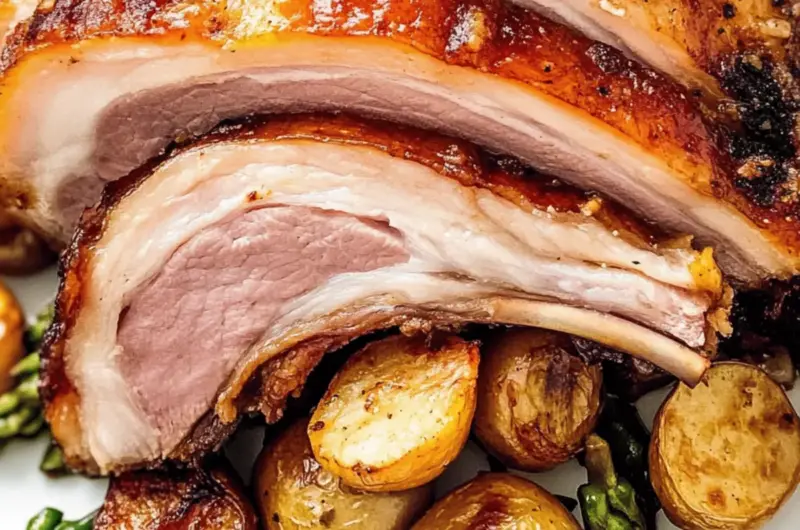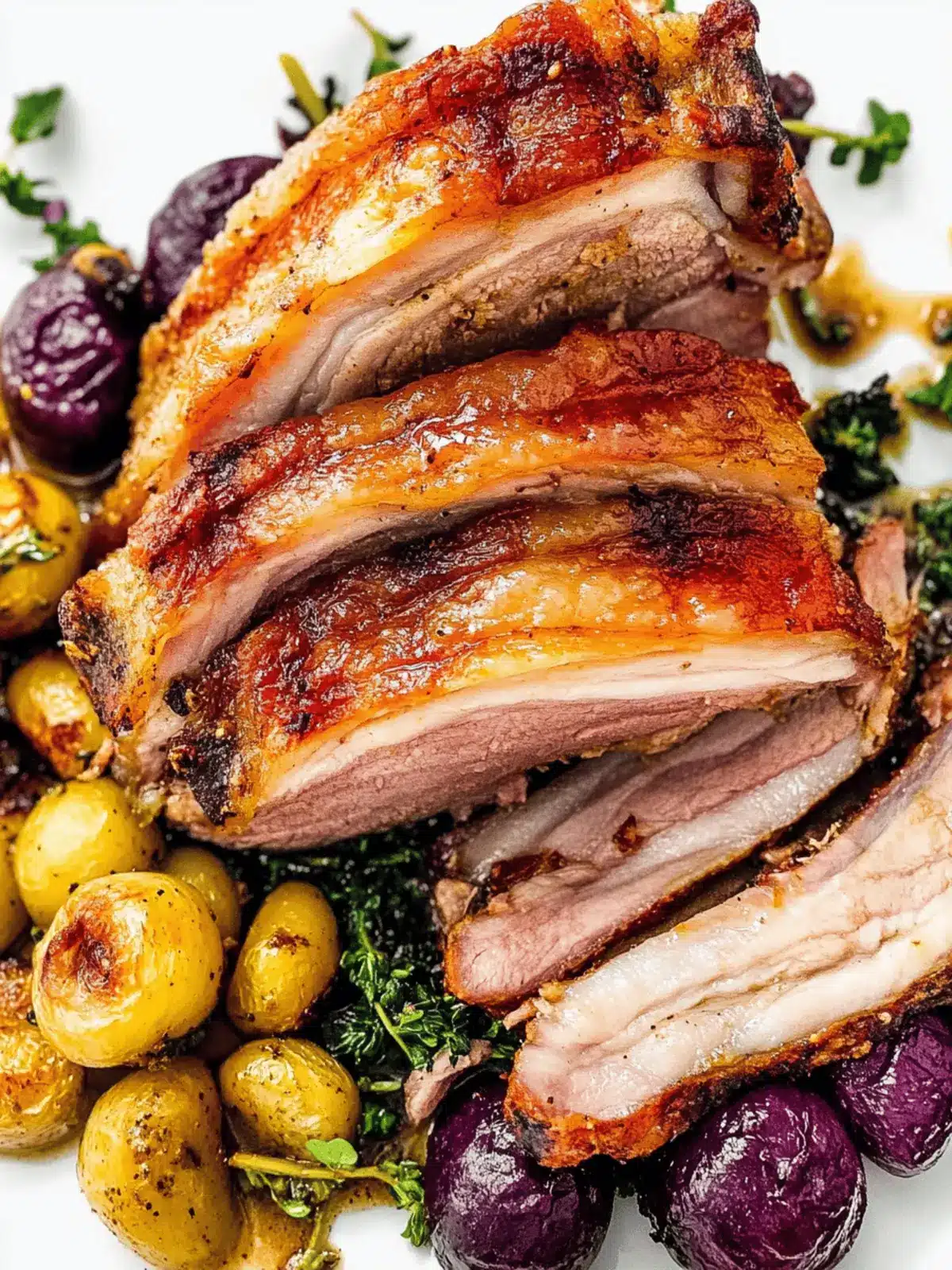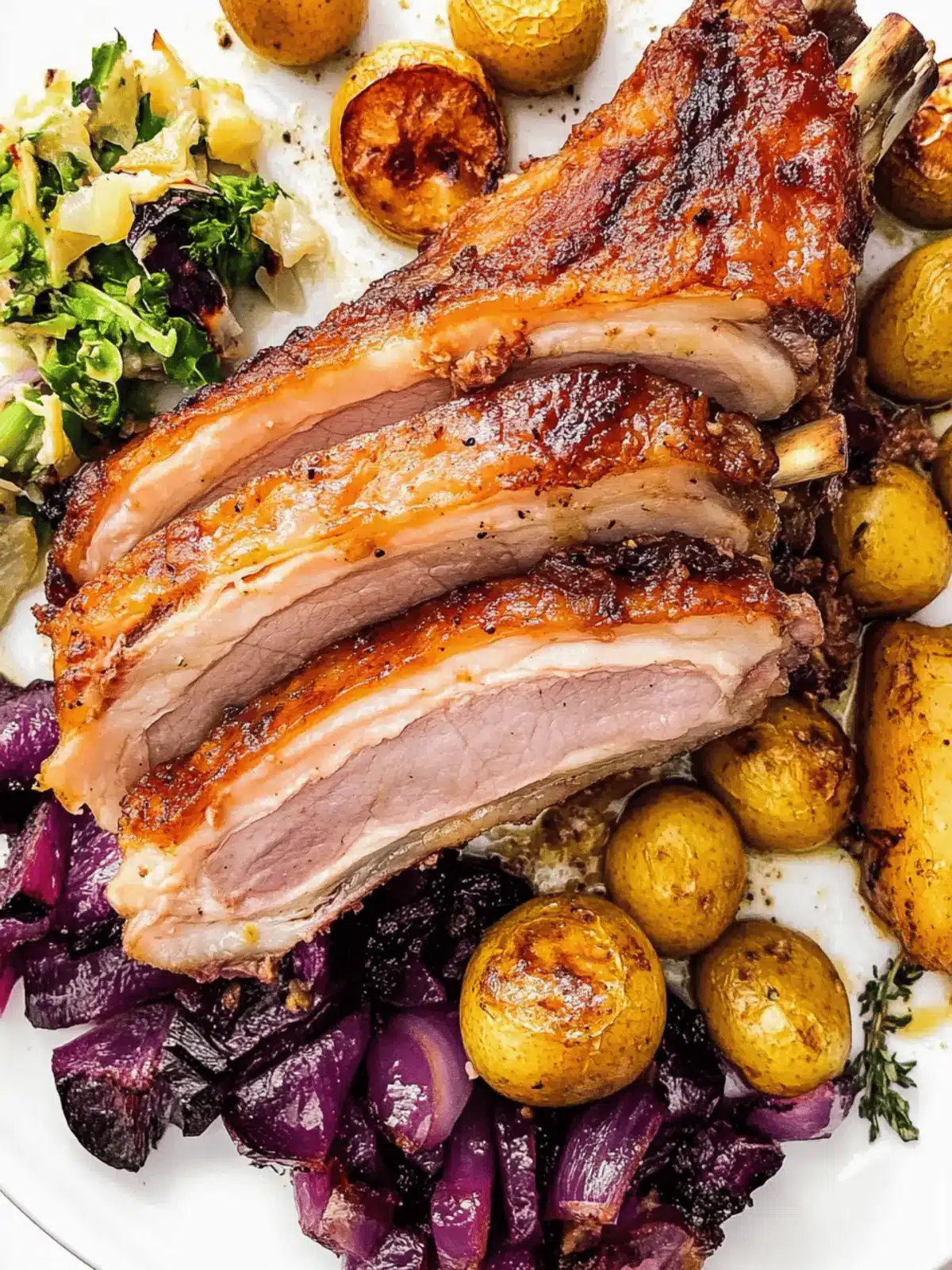The kitchen was filled with the rich, mouthwatering aroma of pork sizzling away in the oven—a sound that always brings a smile to my face. When it comes to comfort food, nothing quite compares to a perfectly crispy slow roast pork belly with cider gravy. This British classic transforms an ordinary Sunday into a memorable feast, where each bite offers crunchy crackling and tender meat bathed in a silky sauce that leaves you wanting more.
I first tried my hand at this recipe on a chilly autumn afternoon, wanting something that felt both luxurious and homey. What I discovered was not just a meal, but a delightful centerpiece that evokes warmth, laughter, and a sense of belonging. With minimal prep and a touch of patience, you can impress family and friends alike while indulging in the flavors of the season. Let’s dive into this easy yet impressive dish that’s sure to revive your love for homemade food!
Why choose Slow Roast Pork Belly with Cider Gravy?
Unmatched Flavor: The blend of succulent pork with cider gravy delivers a comforting and rich taste that will have everyone asking for seconds.
Crispy Perfection: Achieving that coveted crackling is easier than you think, requiring just a few simple steps for the ultimate crunch.
Time-Saving Delight: With minimal prep, this dish allows you to relax while it roasts to perfection, making it perfect for busy weekends.
Crowd-Pleasing Choice: This roast is not just a meal; it’s the centerpiece of any gathering, promising to impress all your guests.
Versatile Pairings: Serve it alongside Yorkshire puddings or braised red cabbage for a complete British feast. Consider exploring more delicious recipes for different occasions through our popular roast recipes.
Slow Roast Pork Belly with Cider Gravy Ingredients
For the Pork Belly
- Bone-in Pork Belly – Select a piece with good fat content for the best crackling.
- Ground Black Pepper – Enhances flavor and adds a subtle kick.
- Coarse Sea Salt – Essential for seasoning and achieving crispy skin.
For the Gravy
- Large Onion – Provides sweetness and depth; swap with shallots if desired.
- Cider (330ml) – Use a dry hard cider to balance the richness of the pork.
- Chicken Stock (250ml) – A flavorful base for your gravy; homemade is perfect!
- Butter (50g) – Adds smoothness; opt for unsalted for better control.
- Salt (to taste) – Final seasoning to adjust flavor perfection.
Now that you have all the ingredients lined up, you’re well on your way to creating a delicious slow roast pork belly with cider gravy that will warm your home and satisfy your guests!
How to Make Slow Roast Pork Belly with Cider Gravy
-
Prepare the Pork: Score the skin of the pork belly the night before. Leave it uncovered in the fridge, which helps to dry out the skin—this step is essential for achieving that perfect crackling.
-
Preheat Oven: Heat your oven to its highest setting, around 250°C (480°F), about 15-20 minutes prior to cooking. This initial burst of heat is key to crisping up the skin.
-
Prepare Onions: Slice the large onion and place it in your roasting tin. This aromatic base not only adds flavor but also creates a lovely bed for your pork belly to roast on.
-
Season Pork: Generously rub coarse sea salt and ground black pepper into the scored skin of the pork belly. Lay the pork on top of the sliced onions to start the roasting process beautifully.
-
Initial Roast: Place the roasting tin in the oven and cook for 20-30 minutes until the skin blisters and turns golden brown. Keep an eye on it to ensure it doesn’t burn!
-
Lower Temperature: After the initial roast, reduce the oven temperature to 150°C (300°F). Cook for an additional 2-2½ hours, allowing the meat to turn tender and flavorful.
-
Resting Period: Once cooked, remove the pork from the oven and let it rest for 20-30 minutes. This resting time allows the juices to redistribute, ensuring succulent meat.
-
Make Gravy: Pour out any excess fat from the roasting tin. Next, deglaze the tin with cider, scraping up any sticky bits, and reduce it by half. Add chicken stock and cook it down further by a third.
-
Blend Gravy: Transfer the mixture, including the onions, into a blender. Blend until smooth, then strain through a sieve to achieve a silky texture before bringing it to a gentle boil.
-
Finish Sauce: Whisk in the cold butter into the gravy for added richness. Adjust the seasoning with salt to taste before serving.
Optional: Serve with a sprinkle of fresh herbs for a vibrant touch.
Exact quantities are listed in the recipe card below.
Expert Tips for Slow Roast Pork Belly
-
Dry the Skin: Ensure the pork belly skin is thoroughly dried overnight in the fridge. This is crucial for achieving that irresistible, crispy crackling.
-
Initial High Heat: Start roasting at 250°C (480°F) for the first 20-30 minutes. This high temperature helps blister the skin and sets the foundation for the perfect crackling.
-
Patience with Gravy: Don’t rush the deglazing and reducing process. Allow the cider and stock to reduce properly to concentrate flavors and avoid a watery gravy.
-
Homemade is Best: Always make your own gravy with cider and stock. Pre-packaged options won’t compare to the rich, flavorful results you’ll get from this slow roast pork belly with cider gravy.
-
Resting Matters: Don’t skip the resting period after roasting. This step allows the juices to redistribute throughout the meat, ensuring every bite is tender and juicy.
What to Serve with Crispy Slow Roast Pork Belly with Cider Gravy?
Complement your meal with delightful sides that enhance the richness of this classic dish.
- Yorkshire Pudding: Fluffy and golden, these are perfect for soaking up the cider gravy and adding a traditional touch.
- Braised Red Cabbage: Its sweet and tangy flavor contrasts beautifully with the savory richness, making each bite a delight.
- Glazed Carrots: Tender, sweet carrots harmonize with the pork, providing a vibrant color and sweetness to balance the meal.
- Creamy Mashed Potatoes: Smooth and buttery, they offer the ideal comfort blanketing for the pork’s crispiness and flavorful gravy.
- Roasted Potatoes: Crispy, seasoned potatoes add a hearty crunch and make the meal feel even more indulgent.
- Apple Sauce: Its natural sweetness pairs excellently with pork, providing a fresh contrast to the richness of both the meat and gravy.
- Green Peas: Pop of color and fresh flavor, these sweet peas bring a welcome brightness that lightens the meal.
- A Glass of Cider: Continue the theme with a refreshing glass of dry hard cider to enhance the flavors of your pork belly.
Make Ahead Options
These Slow Roast Pork Belly with Cider Gravy are perfect for meal prep enthusiasts! You can score the skin and season the pork belly up to 24 hours in advance; simply leave it uncovered in the fridge, which helps to dry out the skin for beautifully crispy crackling. The gravy can also be made ahead; store it in the fridge for up to 3 days. When ready to serve, roast the pork as usual and reheat the gravy gently on the stovetop to maintain its silky texture. This approach not only saves time but ensures that the dish is just as delicious when it’s time to enjoy it!
How to Store and Freeze Slow Roast Pork Belly with Cider Gravy
Fridge: Keep any leftovers in an airtight container for up to 3 days. This helps maintain the flavors and moisture of the slow roast pork belly.
Freezer: For longer storage, freeze the cooled pork belly in a vacuum-sealed bag or tightly wrapped in foil for up to 3 months. This preserves its deliciousness for future meals.
Reheating: When ready to enjoy again, thaw overnight in the fridge. Reheat in the oven at a low temperature (about 150°C or 300°F) to preserve the crackling texture.
Gravy Storage: Store the cider gravy separately in the fridge for up to 3 days or freeze for up to 2 months. Reheat gently on the stovetop before serving.
Slow Roast Pork Belly with Cider Gravy Variations
Looking to personalize your slow roast pork belly? Here are some delicious ideas to help you make this dish uniquely yours!
-
Apple Cider: Swap in a sweeter apple cider for a milder, fruitier gravy that complements the pork beautifully.
-
Dijon Mustard: Add a tablespoon of Dijon mustard to your gravy for a tangy kick. The mustard adds an exciting depth of flavor that will surprise your taste buds.
-
Herb Infusion: Toss in fresh herbs like thyme or rosemary when making the gravy. This aromatic addition will elevate the overall flavor profile brilliantly.
-
Maple Syrup: Drizzle a touch of maple syrup into the gravy for a hint of sweetness that beautifully balances the savory elements of the dish.
-
Smoky Paprika: Infuse some smoky paprika into your rub for the pork belly. This adds a wonderful smokiness that creates a delightful contrast with the crispy skin.
-
Spicy Twist: Incorporate a chopped jalapeño or a dash of chili powder into the onion mixture for a spicy kick that adds excitement to the gravy.
-
Vegan Version: Use jackfruit instead of pork for a plant-based approach. Slow cook it with spices and serve it with a cider-infused gravy made from vegetable stock.
-
Quinoa Side: Serve the pork with a side of lemon-infused quinoa for a hearty yet healthy accompaniment. This light dish provides balanced textures and flavors.
Slow Roast Pork Belly with Cider Gravy Recipe FAQs
What type of pork belly should I select for the best crackling?
Choose a bone-in pork belly with a good layer of fat. The fat is crucial for achieving that crunchy crackling that we all love. Look for pork belly that has a firm texture and even distribution of fat.
How long can I store leftover slow roast pork belly?
You can store leftover slow roast pork belly in an airtight container in the fridge for up to 3 days. Just make sure it’s properly cooled before sealing to retain its moisture and flavor.
Can I freeze slow roast pork belly and how?
Absolutely! For freezing, it’s best to cool the pork belly completely first. Then, wrap it tightly in foil or place it in a vacuum-sealed bag before placing it in the freezer. It should stay good for up to 3 months. For the best results, thaw overnight in the fridge before reheating.
How can I prevent my gravy from being too watery?
To avoid watery gravy, make sure to allow the cider to reduce by half before adding the chicken stock. The combined reduction should then be reduced further by a third. It’s also helpful to blend in the onions; they will thicken the gravy and add depth. Just remember, patience here is vital for that rich flavor!
Is there a dietary consideration for pets or allergies with this recipe?
Yes, this recipe contains pork, cider, and butter, which may not be suitable for pets. Additionally, be cautious if you have allergies to any of the seasonings or ingredients, especially the cider or any specific spices. Always check labels if using store-bought products, particularly for chicken stock.
What should I do if my crackling isn’t crispy?
If your crackling isn’t crispy, it might be due to insufficient drying or heat. Ensure that the skin is well-dried the night before and consider scoring deeper. Also, make sure your oven was preheated well before adding the pork. If it comes out chewy, finish it under the broiler for a couple of minutes at the end, but keep an eye on it to avoid burning.

Delicious Slow Roast Pork Belly with Cider Gravy You’ll Love
Ingredients
Equipment
Method
- Score the skin of the pork belly the night before and leave it uncovered in the fridge to help dry out the skin.
- Preheat your oven to its highest setting, around 250°C (480°F), 15-20 minutes prior to cooking.
- Slice the large onion and place it in your roasting tin.
- Generously rub coarse sea salt and ground black pepper into the scored skin of the pork belly.
- Place the roasting tin in the oven and cook for 20-30 minutes until the skin blisters and turns golden brown.
- Reduce the oven temperature to 150°C (300°F) and cook for an additional 2-2½ hours.
- Remove the pork from the oven and let it rest for 20-30 minutes.
- Pour out any excess fat from the roasting tin and deglaze it with cider, then add chicken stock and cook down further.
- Transfer the mixture including onions into a blender. Blend until smooth and strain through a sieve.
- Whisk in cold butter to the gravy and adjust seasoning with salt to taste.











